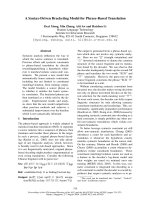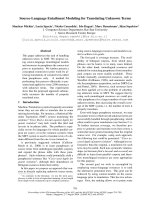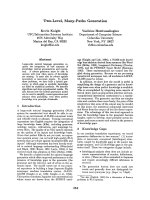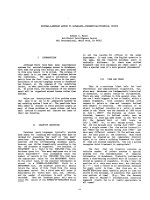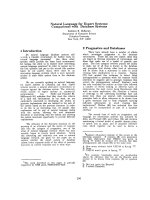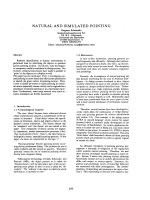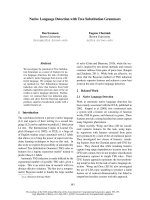Báo cáo khoa học: "NAtural Language driven Image Generation" doc
Bạn đang xem bản rút gọn của tài liệu. Xem và tải ngay bản đầy đủ của tài liệu tại đây (474.43 KB, 6 trang )
NAtural Language driven Image Generation
Giovanni Adorni, Mauro Di Manzo and Fausto Giunchiglis
Department of Communication, Computer and System Sciences
University of Genoa
Via Opera Pia i] A - 16145 Genoa - Italy
ABSTRACT
In this paper the experience made through the
development of a NAtural Language driven Image
Generation is discussed. This system is able to
imagine a static scene described by means of a
sequence of simple phrases. In particular, a theory
for equilibrium and support will be outlined
together with the problem of object positioning.
i. IntrOduction
A challenging application of the AI
techniques is the generation of 2D projections of
3D scenes starting from a possibly unformalized
input, as a natural language description. Apart
from the practically unlimited simulation
capabilities that a tool of this kind could give
people working in the show business, a better
modeling of the involved cognitive processes is
important not only from the point of view of story
understanding (Wa8Oa,WaS]a), but also for a more
effective approach to a number of AI related
problems, as, for instance, vision or robot
planning (So76a). In this paper we discuss some of
the ideas on which is based a NAtural Language
driven Image Generation (NALIG from here on) which
has been developed for experimental purposes at the
University of Genoa. This system is currently able
to reason about static scenes described by means of
a set of simple phrases of the form: csubject~
~preposition~ cobject, [ creference~ ] (*).
The understanding process in NALIG flows
through several steps (distinguishable only from a
logic point of view), which perform object
instantiation,
relation
inheritance, translation of
the surface expression
into
unambiguous primitives,
(*) NALIG has been developed for the Italian
language; the prepositions it can presently analyze
are: su, sopra, sotto, a destra, a sinistra, vici-
no, davanti, dietro, in. A second deeply revised
release is currently under design.
This work has been supported by the Italian Depart-
ment of Education under Grant M.P.I 27430.
consistency checking, object positioning and so on,
up to the drawing of the "imagined" scene on a
screen. A general overview of NALIG is given in the
paper, which however is mainly concerned with the
role of common sense physical reasoning in
consistency checking and object instantiation.
Qualitative reasoning about physical processes is a
promising tool which is exciting the interest of an
increasing number of A.I. researches
(Fo83a,Fo83b,Fo83c) , (Ha78a,Ha79a) , (K179a,K183a).
It plays a central role in the scene description
understanding process for several reasons:
i. naive physics, following Hayes definition
(Ha78a), is an attempt to represent the common
sense knowledge that people have about the
physical world. Sharing this knowledge between
the speaker and the listener (the A.I. system,
in our case) is the only feasible way to let
the second make realistic hypotheses about the
assumptions underlying the speaker utterances;
ii. it allows to reach conclusions about problems
for which very little information is available
and which consequently are hard to formalize
using quantitative models;
iii. qualitative reasoning can be much more
effective to reach approximate conclusions
which are sufficient in everyday life. It
allows to build a hierarchy of models in order
to use every time the minimal requested amount
of information, and avoid to compute
unnecessary details.
Within the framework of naive physics, most of
the current literature is devoted to dynamic
processes. As far as we are concerned with the
description of static scenes, other concepts are
relevant as equilibrium, support, structural
robustness, containment and so on. With few
exceptions (Ha78a), qualitative theories to address
these problems are not yet available even if some
useful suggestions to approach statics can be found
in (By8Oa). In this paper, a theory for
equilibrium and support will be outlined. An
important aspect of the scene description
understanding process is that some amount of
495
qualitative analysis can never be avoided, since a
well defined position must be completed for every
object in order to draw the image of the scene on a
screen. This computation must not result in an
overspecification that masks the degree of
fuzziness which is intrinsic in object positions
(Wa79s), in order to avoid to unnecessarily
constrain all the following reasoning activities.
The last section of the paper will be devoted to
the object positioning problem.
2.
Object taxonomy and spatial primitives
Spatial prepositions in natural language are
often ambiguous, and each one may convey several
different meanings (Bo79a,He80a). Therefore, the
first step is to disambiguate descriptions through
the definition of a proper number of "primitive
relationships.
The selection of the primitive relation
representing the meaning of the input phrase is
based mainly, but not only, on a taxonomy of the
involved objects, where
they
are classified
depending on attributes which, in turn, depend on
the actual spatial preposition. An example may be
given by the rules to select the relation
H SUPPORT(A,B) (that is A is horizontally supported
by B) from the phrase "A on B".
This meaning is chosen by default when some
conditions are satisfied. First of all, A must not
bel~g to that special category of objects which,
when properly used, are flying, as aircrafts,
unless B is an object expressly devoted to support
them in some special case: so, "the airplane on the
runway" is likely to be imagined touching the
ground, while for the "airplane on the desert" a
flying stats is probably inferred (of course, the
authors cannot exclude that NALIG default reasoning
is biased by their personal preferences).
FLYING(A) and REPOSITORY(A,B) predicates are used
to formalize these facts. To be able to give
horizontal support, B must have a free upper
surface ((FREETOP(B)), walls or ceilings or closed
doors in an indoor view do not belong to this
category. Geographic objects (GEO(X)) impose a
special care: "the mountains on the lake" cannot be
interpreted as the lake supporting the mountains
and even if only B is a geographic object, but A
can fly, physical contact seems not to be the most
common inference ("the birds on the garden").
Hence, a first tentative rule is the following (the
actual rule is much more complex):
not GEO(A) and not(FLYING(A) and
not REPOSITORY(A,B)) and
((FREETOP(B) and not GEO(B)) or
(GEO(B) and not CANFLY(A)))
===~, H SUPPORT(A,B)
A complete discussion of NALIG's taxonomy of
objects is in (Bo83a). Both the set of primitives
and the set of attributes have been defined on the
basis of empirical evidence, through the analysis
of some thousands of sample phrases. Besides the
fact that NALIG works, there are specific reasons
to accept the current taxonomy, and it is likely
that further experience will suggest modifications;
however, most of knowledge in NALIG is descriptive,
and the intrinsic flexibility of an expert system
approach an easy stepwise refinement.
The values of some predicates are simply
attempts to summarize large amounts of specified
knowledge. For example, CANFLY(X) is true for
birds, but FLYING(X) is not; the last predicate is
reserved for airplanes and similar objects. This is
a simple trick to say that, in common experience,
airplanes can be supported by a very limited set of
objects, as runways, aircraft carrier ships and so
on, while birds can stay almost everywhere and to
list all possible places is too space wasting.
However, most of them are directly related to
geometrical or physical properties of obje~ts, to
their common uses in a given environment and so on,
and should be always referred to underlying
specific theories. For instance, a number of
features are clearly related to a description of
space which is largely based on the Hayes' model to
develop a theory for the containment of liquids
(Ha78a). Within this model some predicates, as
INSIDE(O), can be evaluated by means of a deeper
geometric modeling module, which uses a generalized
cone approach to maintain a more detailed
description of the structures of objects
(Ad82a,Ad83a,Ad83b).
Some of these theories are
currently under development (a naive approach to
statics will be outlined in the following), some
others are still beyond the horizon; nevertheless,
for experimental purposes, unavailable
sophisticated theories can be substituted by rough
approximations or even by fixed valued predicates
with only s graceful degradation of reasoning
capabilities.
Taxonomical rules generate hypotheses about
the most likely spatial primitive, but these
hypotheses must be checked for consistency, using
knowledge about physical processes (section 4) or
about constraints imposed by the previous
allocation of other objects (section 5). Moreover
there are other sources of primitive relations
besides the input phrase. One of the most important
sources is given by a set of rules which allow to
infer unmentioned objects; they are briefly
496
outlined in the next section. Other relations may
be inferred as side-effects of consistency checking
and positioning activities.
the branch and the roof becomes unlikely. A deeper
discussion of these inference rules is presented in
(Ad83c).
3. Object
instantiation
Often a natural language description gives
only some details about the scene, but many other
objects and relations must be inferred to satisfy
the consistency requirements. An example is the
phrase "a branch on the roof" which is probably
interpreted as "a tree near the house having a
branch on the roof"." Therefore a set of rules has
been defined in NALIG to instantiate unmentioned
objects and infer the relations holding between
them.
Some of these rules are based on knowledge
about the structure of objects, so that, under
proper conditions, the whole can be inferred when a
part is mentioned. Other rules take into account
state conditions, as the fact that a living fish
need water all around, or containment constraints,
as the fact that water is spread on a plane surface
unless it is put into a suitable container. The
inferred objects may inherit
spatial
relations from
those explicitly mentioned; in such a case relation
replacement rules are needed. A simple example is
the following. Geographic objects containing
water, as a lake, can be said to support something
(the boat on the lake), but the
true
relation holds
between the supported object end the water; this
fact must be pointed out because it is relevant for
consistency conditions. Therefore a replacement
rule is :
ON(A,B) and GEO(B) and OPENCONTAINER(B) and
not GEO(A) and not (FLYING(A) and
not REPOSITORY(A,B)) and not CANFLY(A)
==~ ON(A,water) and CONTAINED(water,B)
where ON(X,Y) represents the phrase to be analyzed;
OPENCONTAINER (X) has the same formal meaning
defined by Hayes (Ha78a) and describes a container
with an open top.
When relation inheritance does not apply,
relative positions between known and inferred
objects must be deduced from knowledge about their
structures and typical positions. For instance the
PARTOF instantiation rule, triggered by the phrase
"the branch on the rool
TM
to infer a tree and a
house, does not use the relation inheritance (the
tree is not on the house), but knowledge about
their typical positions (both objects are usually
on the ground with assumed standard axis
orientations) or structural constraints, as the
house cannot be too high and the tree too far from
the house, otherwise the stated relation between
4.
Co~istency checking and qualitative
reas~d~g
Objects which do not fly must be supported by
other objects. This seemingly trivial
interpretation of the law of gravity plays a basic
role when we check the consistency of a set of
given or assumed spatial relationships; no object
is properly placed in the imagined scene if it is
not possible to relate it, possibly through a chain
of other supporting objects, to one which has the
role of "ground" in the assumed environment (for
instance floor, ceiling and interior surfaces of
walls in an indoor view). The need of justifying
this way all object positions may have effects on
object instantiation, as in the phrase "the book on
the pencil". Since the pencil cannot give full
support to the book another object must be assumed,
which supports the pencil and, at least partially,
the book; both objects could be placed directly on
the floor, but default knowledge about the typical
positions that books and pencils may have in common
will probably iced to the instantiation of the
table as the most likely supporting object, in turn
supported
by
the floor.
The supporting laws may also give guidance to
the positioning steps, as in the phrase "the car on
the shell
TM
where, if there are reasons to reject
the hypothesis that the car is a toy, then it is
unlikely to have the shelf in its default position,
that is "on the wall".
"""~/. {" l ,,~ [°]
Wall WO|I
fig. l:assumed and default shelf structures
Another example of reasoning based on
supporting rules is given by assumptions about the
structure of objects, in those cases in which a
number of alternatives is known. For instance, if
we know that "a shelf on the wall" must support a
heavy load of books, we probably assume the
structure of fig.la, even if fig.lb represents the
default choice.
To reason about these facts we need a strategy
to find the equilibrium positions of an object or a
pattern of supports, if such positions exist,
taking into account specific characteristics of the
involved objects. This strategy must be based, as
497
far as possible, on qualitative rules, to avoid
unnecessary calculations in simple and common cases
and to handle ill-defined situations; for instance,
rules to grasp objects, as birds, are different
from those helding for not grasping ones, as
bottles, and nearly all situations in which birds
are involved can be solved without any exact
knowledge about their weight distributions,
grasping strength and so on.
An example of these rules, which we call
"naive statics" is given in the following. Let us
consider a simple case in which an object A is
supported by another object B; the supported object
has one or more plane faces that can be used as
bases. If a face f is a base face for A
(BASE(f,A)), it is possible to find the point e,
which is the projection of the barlcenter of A on
the plane containing f along its normal. It is
rather intuitive that a plane horizontal surface is
a stable support for A if the area of physical
contact includes e and if this area is long and
wide enough, in comparison to the dimensions of A,
and its height in particular. Hence a minimum
equilibrium area (M_E_AREA(a,f)) can be defined for
each BASE f of A (this in turn imposes some
constraints on the minimal dimensions of f).
The upper surface of B may be of any shape. A
support is a convex region of the upper surface of
B; it may coincide with the whole upper surface of
B, as it happens with a table top, or with a
limited subset of it, as a piece of the upper edge
of the back of a chair. In this example we will
consider only supports with a plane horizontal top,
possibly shrinking to a line or a point; if s is
such a part of B, it will be described by the
predicate P_SUPP(s,B).
Let's consider now an object A, with a regular
base f, lying on one or more supports whose upper
surfaces belong to the same plane. For each
position of A there is a pattern of possibly
disconnected areas obtained from the intersection
of f with the top surfaces of the supports. Let be
a the minimal convex plane figure which include all
these areas; a will be referred to as a supporting
area (S_AREA(a)). A rather intuitive definition of
equilibrium area is that A is stable in
that
position if its M_E_AREA(a,f) is contained in the
supporting area. A further condition is that a
free space V around the supports must exist, large
enough to contain A; this space can be defined by
the smallest convex volume Va enveloping A which is
part of the description of A itself. Therefore
conditions of stable lying can be formulated as
follows:
BASE(f,A) and LAY(A,B) and
FREE(V) and ENVELOP(Va,A) and CONTAINED(Va,V)
=9
STABLE_H_SUPPORT(A,B)
where:
LAY(A,B)E
P_SUPP(sI,B) and , and P_SUPP(sn,B)
and S_AREA(a) and M_E_AREA(e,f) and
CONTAINED(e,a)
The evaluation of the supporting area (i.e. to
find an area a for which its predicate S_AREA(a) is
true)
may be trivial in some cases and may require
sophisticated positioning strategies in other
cases. The most trivial case is given by a single
support S, in this case we have S_AREA(TOP(S)),
which means that the supporting area a coincides
with the top surface of S.
[.]
i
fig.2: radial simmetry
Another simple but interesting case is given by
regular patterns of supports, where it is possible
to take advantage of existing simmetries. Let' s
consider, for instance, a pattern of supports with
radial simmetry, as shown in fig. 2a, which may
resemble a gas_stove. If the base f of a has the
same kind of approximately radial simmetry (a
regular polygon could be a good approximation) and
if the projection c of the baricenter of A
coincides with the center of f, then the supporting
a is the circle with radius Ra under the condition
r R, where r is the radius of the "central hole"
in the pattern of supports and R is the (minimal)
radius of f. This simply means that the most
obvious positioning strategy is to center A with
respect to the pattern of supports; their actual
shape is not important provided that they can be
touched by A. In case of failure of equilibrium
rules a lower number of supports must be considered
and the radial simmetry is lost (for instance, the
case of a single support may be analyzed).
[°] l,'
TYPE b
fig.3: axial simmetry
[~]
~,- y 1
TYPEa
~y2
TVPEC
-'~Y3
498
AS a third example let us consider a couple of
supports with an axis simmetry as shown in fig.3a
(straight contours are used only to simplify the
discussion of this example, but there are not
constraints on the actual shapes (besides
simmetry). If the face f for A exhibits the same
kinds of simmetry (fig.3b) the simplest placement
strategy is to align the object axis to the support
one. In this case the interior contours of each
support can be divided into a number of intervals,
so that for each interval [ Xi, Xi+l ] we have:
a. min d(x) ,= max D(y) or
I xi,xi+1
} y
b.
C.
max d(x) < min D(y) or
{ xi,xi+1
}
y
{ rain
d(x) ~'= rain D(y)} and
[ xi,xi+1
] y
{ max
d(x) ,~ max D(y) }
{ xi,xi+1
]
y
Analogously the object contour can be divided
in intervals, so that for each interval [ Yj, Yj+I
we have:
A. min D(y) ~ max d(x) or
[
Yj,Yj+I }
x
B.
max ~(y)
(=
min d(x) or
{ Yj,Yj+I }
x
C.
rain O(y) ~ rain d(x) and
[
Yj,Yj+I
]
x
max D(y)
(= max
d(x)
[
Yj,Yj+I I x
Of course, some situations are mutually
exclusive (type a with type A or type b with type B
intervals).
PPSU~)RTIN G ARiA
fig.4:supporting area
Equilibrium positions may be found
superimposing object intervals to support one by
means of rules which are specific for each
combination of types. For example, one type A and
one type b intervals can be used to search for an
equilibrium position by means of a rule that can be
roughly expressed as:
"put type A on type c and type C on type b so that
the distance t (see fig.4) is maximized".
The supporting area a obtained this way is
shown (the dashed one) in fig.4. This kind of
rules can be easily generalized to handle
situations as a pencil on a grill. Some problems
arise when the supports do not lie on the other
plane, as for a book supported partially by the
table top and partially by another book; in this
case the concept of friction becomes
relevant. A
more detailed and better formalized description of
naive statics can be found in (Di84a).
5. Positioning objects in the scene
A special positioning module must be invoked
to compute the actual coordinates of objects in
order to show the scene on the screen. This module,
which we mention only for lack of space, has a
basic role, since it coordinates the knowledge
about the whole scene, and can therefore activate
specific reasoning activities. For instance, there
are rules to handle the transparency of some
objects with respect to particular relations and
possibly to generate new relations to be checked on
the basis of the previously discussed criteria. An
example is the phrase "the book on the table",
which is accepted
by
the logic module as
H_SUPPORT(book,table) but can be rejected at this
level if there is no enough free space on the table
top, and therefore modified into a new relation
H_SUPPORT(book,B), where B is a suitable object
which is known to be supported by the table and is
transparent to respect the On relationship (another
book, for instance). A more detailed description
can be found in (Ad84a).
6. Conclusions
NALIG is currently able to accept a
description as a set of simple spatial relations
between objects and the draw the imagine scene on a
screen. A number of problems are still open,
mainly in the area of knowledge models to describe
physical phenomena and in the area of a suitable
use of fuzzy logic to handle uncertain object
positions. Apart from these enhancements of the
current release of NALIG, future work will be also
focused (ml the interoonnection of NALIG with an
animation system which is under development at the
University of Genoa (Mo84a), in order to explore
also those reasoning problems that are related to
the description of actions performed by human
actors.
499
REFERENCES
Ad82a. Adorni,G., Boccalatte,A., and DiManzo,M.,
"Cognitive Models for Computer Vision",
Proc. 9th. COLING, pp. 7-12 (Prague,
Czechoslovakia, July 1982).
Ad83a. Adorni,G. and DIManzo,M., "Top-Down
Approach to Scene Interpretation", Proc,
CIL-83, pp. 591-606 (Barcelona, Spain,
June 1983).
Ad83b. Adorni,G., DiManzo,M., and Ferrari,G.~
"Natural Language Input for Scene
Generation", Proc. ist. Conf. of the
European Chapter of the ACL, pp. 175-182
(Pisa, Italy, September 1983).
Ad83c. Adorni,G., DiManzo,M., and Giunchiglia,F.,
"Some Basic Mechanisms for Common Sense
Reasoning about Stories Envinronments",
Proc. 8th. IJCAI, pp. 72-74 (Karlsruhe,
West Germany, August 1983).
Ad84a. Adorni,G., Di Manzo,M., and Giunchiglia,F.,
"From Descriptions to Images: what
Reasoning in between?", to appear in Proc.
6th. ECAI, (Pisa, Italy, September 1984).
Bo79a. Boggess,L.C., "Computational Interpretation
of English Spatial Prepositions", TR-75,
Coordinated Sei. Lab., Univ. of Illinois,
Urbana, ILL (February 1979).
Bo83a. Bona,R. and Giunchiglia,F., "The semantics
of some ~patial prepositions: the Italian
case as an example", DIST, Technical
Report, Genoa, Italy (January 1983).
By8Oa. Byrd,L. and Borning,A., "Extending MECHO to
Solve Static Problems", Proc. AISB-80
Conference on Artificial Intelligence,
(Amsterdam, The Netherlands, July 1980).
Di84a. DiManzo,M., "A qualitative approach to
statics", DIST, Technical Report, Genoa,
Italy (June 1984).
Fo83a. Forbus,K., "Qualitative Reasoning about
Space and Motion", in Mental Models, ed.
Gentner,D., and Stevens,A. ,LEA Publishers,
Hillsdale, N.J. (1983).
Fo83b. Forbus,K., "Measurement Interpretation in
Qualitative Process Theory", Proc. 8th.
IJCAI, pp. 315-320 (Karlsruhe, West
Germany, August 1983).
Fo83c. Forbus,K., "Qualitative Process Theory",
AIM-664A, Massachusetts Institute of
Technology, A.I. Lab., Cambridge, MA (May
1983).
Ha78a. Hayes,P.J., "Naive Phisics I : Ontology for
liquids", Working Paper N.35, ISSCO, Univ.
of Geneve, Geneve, Switzerland (August
1978).
HaVga. Hayes,P.J., "The Naive Physics Manifesto",
in Expert Systems in the Micro Electronic
Age, ed. Michie,D.,Edimburgh University
Press, Edimburgh, England (1979).
He8Oa. Herskovitz,A., "On the Spatial Uses of the
Prepositions", Proe. 18th. ACL, pp. 1-6
(Philadelphia, PEN, June 1980).
K179a. de Kleer,J., "Qualitative and Quantitative
Reasoning in classical Mechanics", in
Artificial Intelli~ence: an MIT
Perspective, Volume I, ed. Winston,P.H. and
Brown,R.H.,The MIT Press, Cambridge, MA
(1979).
K183a. de Kleer,J. and Brown,J., "Assumptions and
Ambiguites in Mechanistic Mental Models",
in Mental Models, ed. Gentner,D., and
Stevens,A.,LEA Publishers, Hillsdale, N.J.
(1983).
Mo84a. Morasso,P. and Zaccaria,R., "FAN (Frame
Algebra for Nem): an algebra for the
description of tree-structured fi~zres in
motion", DIST, Technical Report, Genoa,
Italy (January 1984).
So78a. Sondheimer,N.K., "Spatial Reference and
Natural Language Machine Control", Int. J.
Man-Machine Studies Vol. 8 pp. 329-336
(1976).
Wa79a. Waltz,D.L. and Boggess, L., "Visual Analog
Representations for Natural language
Understanding", Proc. 6th. IJCAI, pp.
926-934
(Tokyo, Japan, August 1979).
Wa8Oa. Waltz,D.L., "Understanding Scene
Descriptions as Event Simulations", Proc.
18th. ACL , pp. 7-12 (Philadelphia, PEN,
June 1980).
Wa81a. Waltz,D.L., "Towsmd a Detailed Model of
Processing for Language Describing the
Physical World", Proc. 7th. IJCAI, pp. 1-6
(Vancouver, B.C., Canada, August 1981).
500
